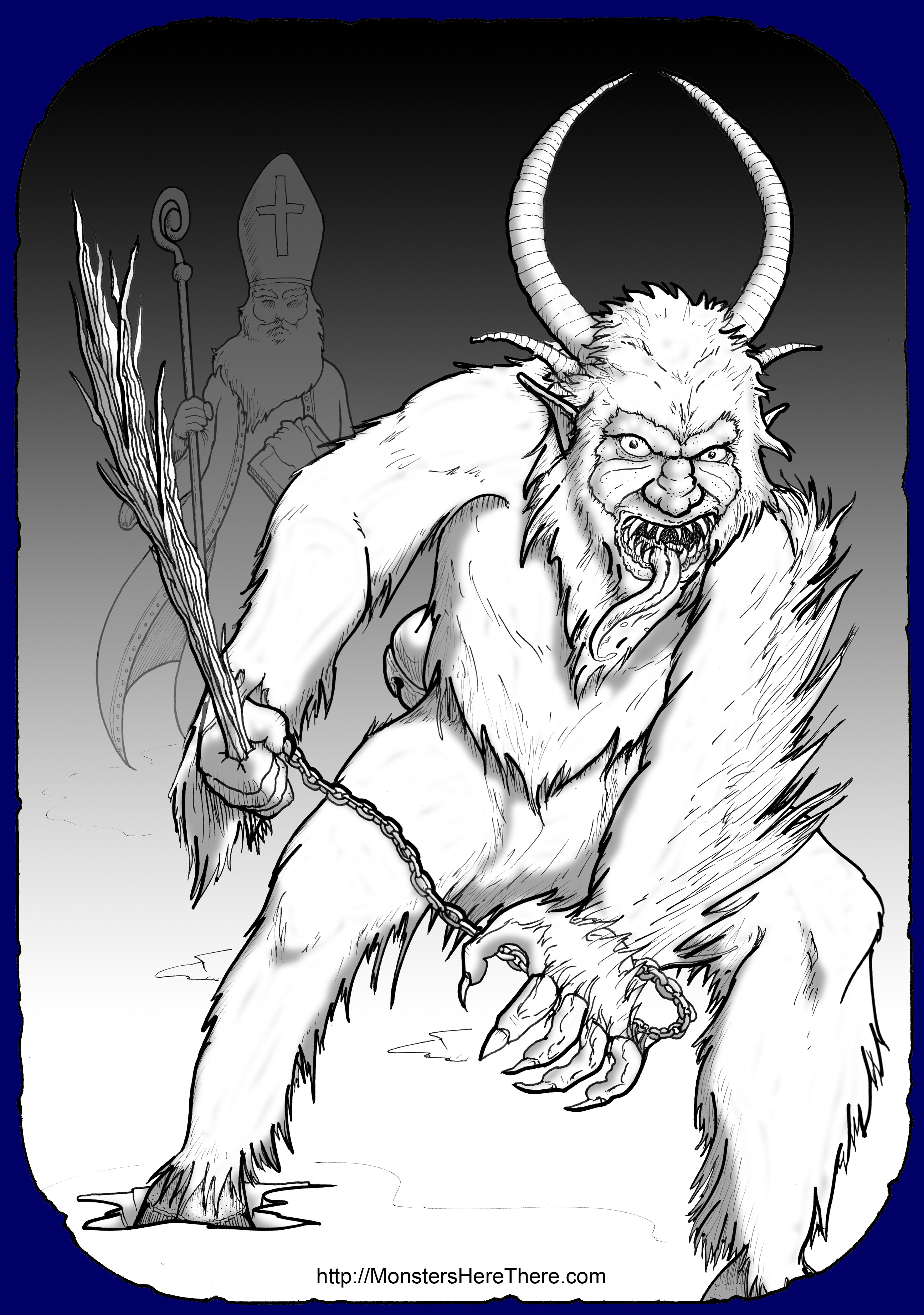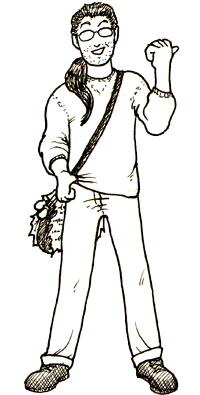| Area(s) Reported: Austria
Date(s) Reported: Ancient Times (?) to Present
In 2015, a new monster started to appear in American horror movies: a Christmas monster named 'The Krampus.' The Krampus' appearance varied from movie to movie: sometimes the creature was dressed like the Santa Claus of American lore and sometimes it was just covered in long, white, shaggy hair... but it was always shown with an impressive set of horns sprouting from its head. In the movies, there is seemingly no agreement about who or what the Krampus actually is, past the common details that the creature is horned, hairy, and somehow associated with Christmas. The reason for this large discrepancy of behavior is simple; the authors of the movies knew very little else about the actual Krampus themselves. You see, the Krampus was not a 'new' monster... Krampus is in fact a very, very old monster. And how ideas about this monster managed to travel from its native Austria out to the rest of the world -- and eventually to Hollywood in America -- is a complicated story. What is depicted now in movies as 'The Krampus' is very different from how the monster started, or even how it is currently thought of in its native environment. Many modern theories -- and fictional stories -- connect the monstrous Krampus back to the religious and magical figures of the ancient European past. However, there's no actual evidence of this being true. So what do we actually know about the creature's past? St. Nicholas is Coming to Town The earliest mentions of the Krampus come from the small country of Austria, and specifically from the traditional December visit of St. Nicholas to towns and houses in the country. Nicholas was a Christian monk who lived from 270 to 343 CE, and performed many kind acts and miracles in his lifetime; after he died, Nicholas was declared to be a 'saint,' a title that denotes he was especially favored by the God of the Bible, and granted special powers to help humanity. St. Nicholas had earned a reputation for helping children and, sometime after his death -- no one seems to know when -- he started to make visits to families and children on December 5 each year, on the eve of the anniversary of his death [and, YES, I'm preparing an article on just St. Nicholas, too!]. These visits were (and are) mostly so the saint could bring gifts to good children and punishments to bad children, as a reminder to them that good behavior will always be rewarded in life. Of course, it's unseemly for a saint to punish children, no matter how bad the kids are; so St. Nicholas almost always visited (and still visits) in the company of a number of companions who have the job of meting out any necessary punishments... though nowadays these companions mainly just frighten or amuse children. These companions vary quite a lot across the area of Europe that St. Nicholas appears in; and in Austria, these companions came to be known as the 'Krampus,' a group name for a set of ever changing companions of strange and frightening character that could come with St. Nicholas either singly or in a group. In all cases, these Krampusse [the proper plural term] were considered to be under the overall control of St. Nicholas, which was and is often symbolized by the creatures carrying or wearing chains. Not much is known about these earliest Krampusse. Their traditional visits with St. Nicholas were very particular to the rural areas of just Austria itself, so not well known of outside those areas. The earliest I've seen mention (a very short mention!) of the Krampus as a holiday related character is in 1825, which isn't all that long ago... and more telling still is that Jacob Grimm (yes, of the 'Brothers Grimm'!) in his massive 1835 study of German mythology and folklore only makes a single mention of the Krampus, and that's as an alternative name for a different St. Nicholas companion that was better known, Knecht Ruprecht (aka "Farmhand Ruprecht" or "Servant Ruprecht"). So while Krampus was around in the early 1800's, the creatures were not considered noteworthy by those taking notes! This lack of notation is what has led to so many inventive idea about the Krampus' past... and, while I have no direct reports about the traditions relating to the Krampus in Austria, quite a bit can be inferred from what clues do exist. Uncomfortable Visits In the places that celebrate St. Nicholas' yearly visits, many families participate merely by leaving shoes out on the night of December 5; good children will find treats and toys filling their shoes... and not-so-good kids will find a switch their parents are expected to swat them with. Alternatively, a large number of families in these places -- and this definitely included the rural areas of Austria -- would actually experience a physical visit from St. Nicholas himself, along with his companions. 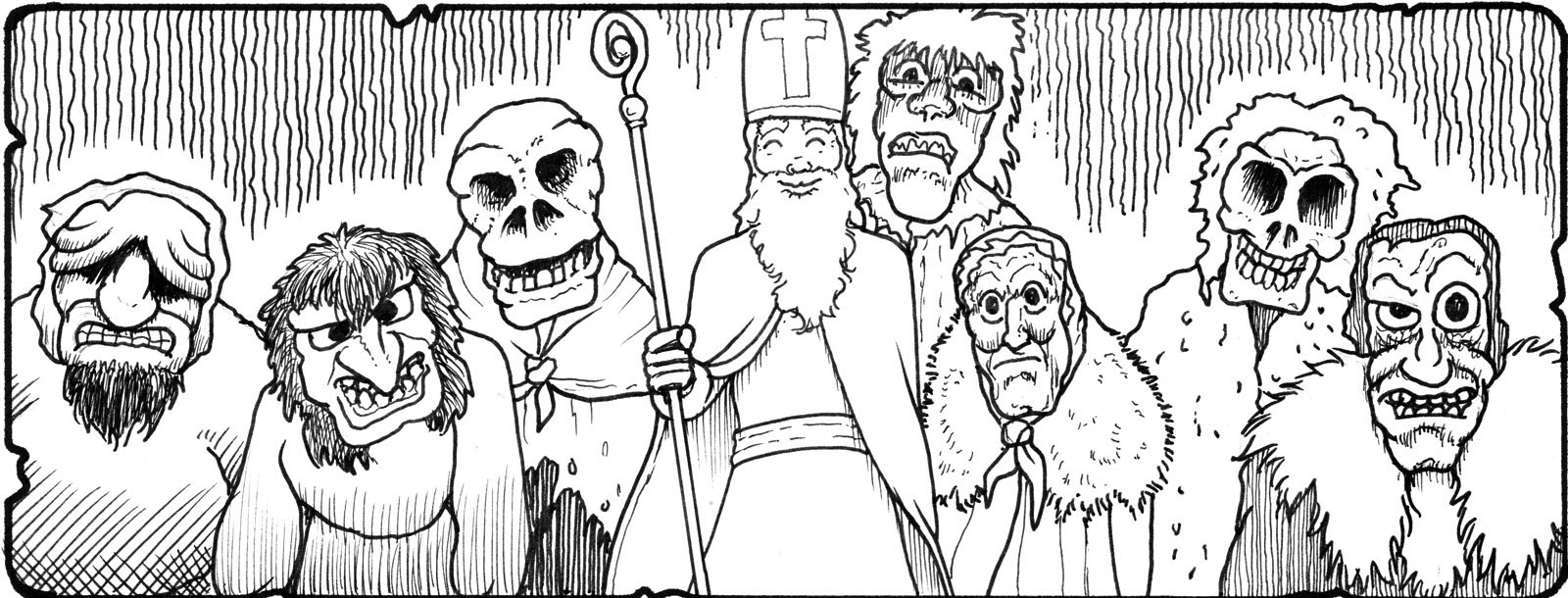
These house visits were (and still are) generally very ritualized. The family would wait for a knock on the door, then lead St. Nicholas and the Krampusse into the room with the family. St. Nicholas would give sweets and small toys to the good children... then the Krampusse would swat the bad children on their legs with a switch, a warning to correct their behavior before the following year's visit. These visits undoubtedly were more of an impression on children than just anonymously receiving treats in shoes; but the saint apparently didn't necessarily visit every famliy (possibly just the ones with problematic children, I suspect). So some families started impersonating St. Nicholas and the Krampus themselves to ensure such a visit always came to their house. Of course, some of you are probably skeptical about the actual existence of St. Nicholas and the Krampusse to begin with... Shame on you! While the costume for St. Nicholas was very standardized -- big white beard, and dressed like a bishop, complete with big hat and staff -- there was no standard idea of what a Krampus looked like. The only requirements appeared to be that any costume created must disguise who was wearing it completely, and be as strange and frightful as possible. Costumes often included old clothes or clothes worn backwards or inside-out, animal skins and furs, and anything else that might be available, like carpets, horns, or animal tails. Faces were blackened with soot and masks generally just had eye-holes; easy to create, and good at hiding the wearer's face. As already mentioned, these practices stayed very local to rural Austria for a very long time, and there's currently no good way for me to determine if any standardized idea existed or developed of what the Krampusse looked like during this time... but in 1898, two big things happened all at once. First, a very standardized idea of the Krampus was created and second, the very idea of the Krampus was spread worldwide. Greetings From Krampus! In 1869, the first postal card -- a card with pre-printed postage on it, not a postcard -- was issued by the government of Austria-Hungary. These were an instant success, because they were cheaper to send than a letter; and soon the initially bland postal cards started to sport a variety of designs and images... including holiday images during holidays. The years 1898 through 1918 have been dubbed the "golden age of postcards" by collectors in the know, and from this time period come some of the most stunning examples of Christmas postal cards and postcards. Within this group of Christmas cards came a new, amusing, sub-genre sent out from Austria... cards bearing the image of a devil-like figure and the slogan "Gruss Vom Krampus," or "Greetings From Krampus." 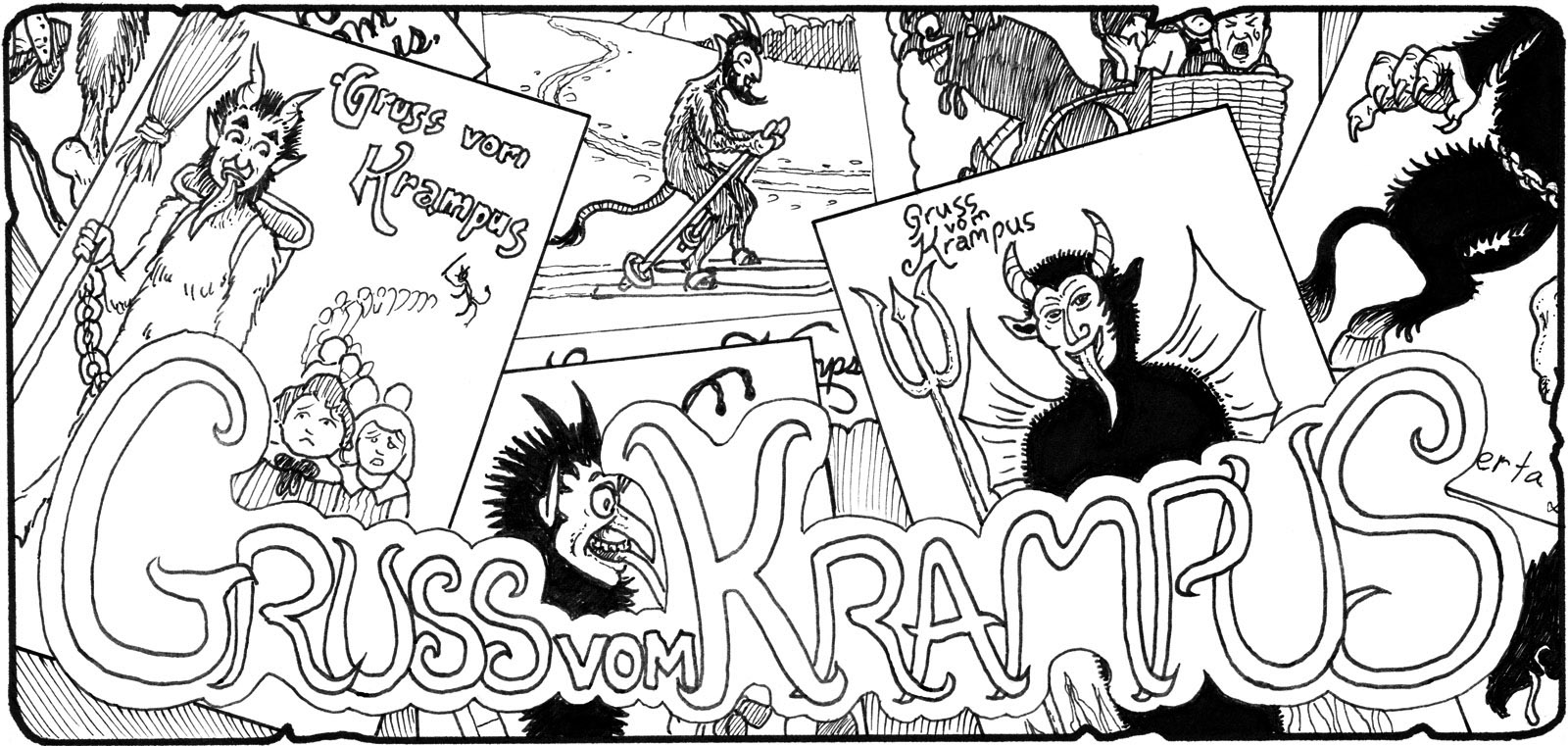
The cards were clearly humorous in nature, but presented an idea that was new to the rest of the world: a monster that participated in Christmas. These cards presented a very distinct picture of Krampus, and of the creature's activities... all very different from the rural idea that existed of the creature. It has been speculated this is because the art was being produced by urban artists who were largely unfamiliar with the rural traditions; with an incomplete idea of Krampus, the artists created their own idea of the creature. The Krampus of the Christmas cards looks like a modified image of the Biblical Devil, male with short horns on his head, goat-like legs, a tail and red skin and/or fur. Another feature sometimes seen in the cards, as my nephew pointed out, is that sometimes this Krampus has one or both feet replaced with a cloven hoof. Added to this creature was an abnormally long tongue lolling out of its mouth; and also new was the idea that this Krampus wore a basket on his back specifically for, as many cards demonstrated, kidnapping naughty children. What was also made clear by the context of the cards was that this "Krampus" was an individual unto itself; though sometimes shown in company with St. Nicholas, the creature was now only rarely shown as one of a group -- so it was THE Krampus, not just A Krampus. These cards were super popular, and were collected by some people the way baseball and pokemon cards are today. But while the cards were creating an idea of a new monster in the world outside of rural Austria, back in the original home of Krampus the old traditions -- and bizarre costumes -- continued unaltered in all but one way; it seems that, over time, more and more people were dressing up like Krampusse for the holiday seasons. The Beast Takes Shape Probably the most important change for the current idea of the Krampusse in Austria itself came in 1930, when sculptor Sepp Lang [1898-1983] realized there was a demand for monsterous masks to be worn by people dressing up as the creatures. Up to that point, masks were very low quality and homemade if they existed; many people still just relied on anything that would cover their faces, masks or not. Sepp Lang created monstrous visages from carved wood, paint, and animal hair. Lang produced both wooden masks for performers, and full Krampus heads for tourist souvenirs... which meant that by 1930 there were now tourists visiting Austria to, in part, see people dressed as Krampusse. 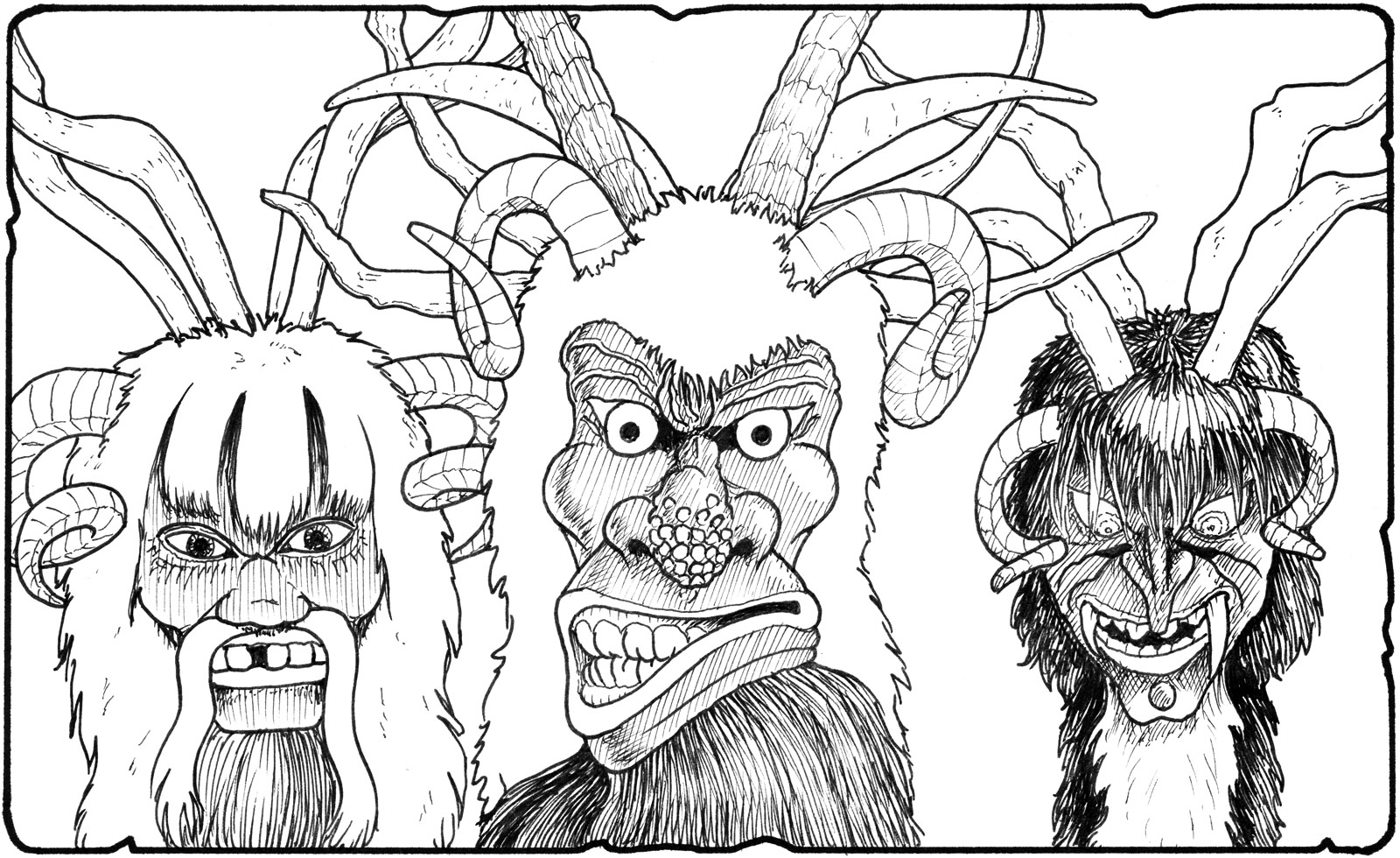
It's also been stated that early in the 1900's, the body suit for Krampus performers became more standardized, leading to actual costumes that would be reused year to year. These new suits were made from the skins of sheep and long-haired goats, creating shaggy bodysuits. Chains were still favored as parts of these costumes, but new to the suits were bells (sometimes huge ones) that would jingle as the Krampusse walked, alerting and warning people the monsters were about. While I have no details about exactly when the bodysuits started to standardize, I suspect it happened about the same time Lang started to add actual faces to the monsters. Lang died in 1983, but by that time the creation of Krampus masks had become a national tradition, with many new creators still producing the masks to this day. Lang's masks often included fantastic horns, in imitation of the use of animal horns by the original attempts to dress as the formless monsters... Lang's horns were much larger than those of the 'Krampus' of the postal cards. But the postal card Krampus did have an influence also, as many new Krampus masks feature variations on the lolling tongue of the postal devil. Too Many Krampusse! With all of this interest in dressing up like a Krampus and an ever-increasing number of people who owned costumes, eventually new excuses were going to be needed to wear the costumes... otherwise house visits -- which still occur -- would have one St. Nicholas and a few hundred Krampusse! So sometime presumably between Lang's introduction of quality masks in 1930 and Lang's death in 1983, a new tradition developed... the Krampuslauf, or "Krampus Run." These are essentially Krampusse parades, part entertainment, and part childhood trauma. People line up along a proposed route to see the run, which is started by a person dressed as St. Nicholas who leads a huge number of Krampusse on the route. The Krampusse growl, jump, pose, and sometimes swat members of the crowd (generally to the cheers of the rest of the crowd). Brave youths will challenge the beasts, and sport a bruise as a mark of bravery! These runs are often associated with Christmas markets, and can occur anytime through December... giving more opportunities for acting troupes to strut their monstery stuff. The earliest printed mention I've seen of a Krampus Run is from 1980, where it was considered a variant on a much older practice called the Perchtenlaufen, or "Perchta Run." Frau Perchta is another winter solstice monster, but by no means a companion of St. Nicholas... and mock battles of women dressed as different aspects of this monstrous lady go well back into the history of Austria and Germany. The newer comparison of the Krampus Run to this older tradition seems to imply that the Krampus Runs might be a very new tradition indeed, dating from just a little before Sepp Lang died in 1983. Interest in the Krampus Runs greatly grew in Austria through the 1990's, and more and more people dressed as Krampusse each year. The "Re-Discovery" of the Krampus Sometime around 2007~2009, there was something of a re-discovery on the internet worldwide of the old Krampus postal cards from the turn of the 19th Century. The bizarre images of the clearly devil-like beast scaring and kidnapping children while offering friendly greetings once again caught the attention of a world that had largely forgotten about the beast from Austria. Websites like Pinterest, interested in pictures but not necessarily stories, spread the old greeting card images far and wide; and soon after, newer sites and books started to explain that the monster was in fact from Austria, and then started to spread pictures of the modern Austrian Krampus Runs, with their fantastic costumes. But as new interest grew in Krampus, actual details and legends about its origins were not readily available, as I've shown... and in America especially, creative people soon started to make their own stories explaining the monster. The best known of these new fictional tales is a 2012 book by a creator only known as Brom, called Krampus: The Yule Lord. Brom wove an inventive tale relating 'The Krampus' to old Norse mythology, and painting the creature as an individual character that was seeking revenge for the imposition of the Christian holiday of Christmas over the older Pagan holiday of Yule. Krampus is presented as being essentially the enemy of the American Christmas legend, Santa Claus... and, unfortunately, many non-Austrians now treat Brom's tale as if it is the correct legendary origin for the Austrian monster. Since Brom's book, the interest in the Krampus has spawned new books and movies, as well as new Krampus Runs from London, England, to Los Angeles in the United States. But make no mistake: the true nature of the Krampus is not in the movies, not in the fictional books, nor even in the postal cards of a hundred years ago... the true nature of the Krampus is well and firmly based in the undocumented past of the folk practices of rural Austria, where a monster with no known form may still hide.
See also: Frau Perchta, St. Nicholas | |
